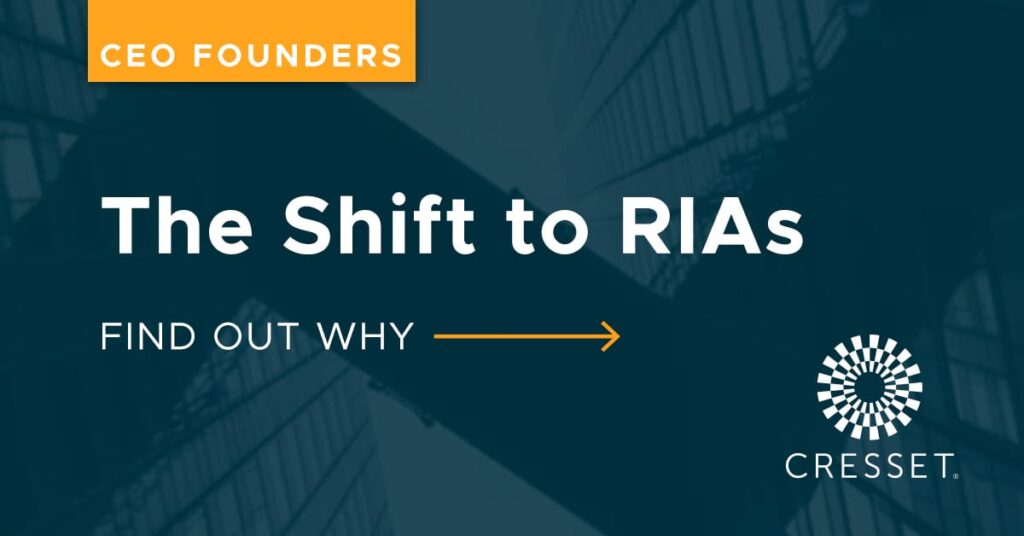
The image of the gray-pillared, monolithic Big Bank is fading with the emergence of a new generation of wealth. A generation that is increasingly demanding transparency, objectivity, and access to new ideas and interesting opportunities.
The percentage of assets managed by Registered Investment Advisors (RIAs) is increasing each year, and that trend is continuing. Why? Big Banks and traditional Wirehouse firms have managed client assets for generations, but contemporary individuals and families of wealth are often seeking three things that the Big Banks and Wirehouses increasingly can’t provide: transparency, objectivity, and access.
But what exactly is it about independent wealth managers that’s driving this share shift away from Big Banks and Wirehouses? We’ve identified five factors to consider:
- Governmental Constraints: After the Great Recession of 2008, the federal government and various regulatory agencies imposed an array of rules and regulations designed to prevent Systemically Important Financial Institutions (SIFIs) from contributing to a future financial collapse. These organizations complied and turned their focus inward at their own processes and procedures. In doing so, many turned their focus away from client intimacy and service. As a result, these organizations talk about clients, not to a client, which means they view clients as a collective, not a collection of individuals.
- True Fiduciary Standards: Many wealth managers claim to have their clients’ best interests at heart. But the truth is, at large public institutions, there are typically various agendas being served: shareholders demanding quarterly growth, which puts pressure on advisors to create new revenue from new and existing clients; in-house-created investment products that carry a higher yield for the firm and are often favored over lower-cost solutions. As a fiduciary choosing to be held to the highest legally recognized standard, independent firms are necessarily aligned with their clients, especially when they can transparently demonstrate that the firm makes money one way, and one way only: by giving sound advice. The reality is not all advisors are created equal, and not all advisors are committed to your best interests. Be diligent about seeking out and working with advisors who are true fiduciaries and have your best interests at heart.
- Smaller Advisor-to-Client Ratio: Big Banks are generally designed to create the highest level of operational efficiency possible: deliver the most product, to the most clients, in the most efficient way possible. That typically results in advisors maintaining relationship loads that can often exceed 100 families. The objective is to create as much homogeneity as possible among services offered in order to create the mythical outcome of “scale.” That is the opposite of personalized service.
- Attracting Top Talent: Top advisors are joining clients in the parade away from Big Banks. Why? It’s simple. Talented advisors want to create meaningful relationships with those they serve. They want the ability to curate a manageable roster of families who can receive their best thinking, best advice, and best solutions – unburdened by the requirement to produce quarterly growth numbers.To keep top advisors productive, Big Banks may undergo periodic “segmentation” exercises to determine “full-share-of-wallet” relationships. That’s when clients who have committed a large amount of their investable net worth to an advisor are transferred to a less-experienced, less-expensive advisor, thus freeing up the senior advisor to seek new, larger clients. While this practice of freeing up capacity for senior advisors is designed to create shareholder value, it tends to disrupt established client relationships and may not always be in the client’s best interests.
- Democratizing the Family Office Experience: Because RIAs are able to more freely determine how they will work with clients, they can provide multi-family office services to clients who historically have not had access to those services, including family governance and education, philanthropy and impact investing, family financial officer engagement, and concierge services. It is more difficult for Big Banks and Wirehouses to provide access to these types of services to all clients. Therefore, only a select few generally receive these benefits.
In addition, financial regulations prevent Big Banks and brokerage institutions from “selling away,” which means they are not permitted to offer clients investment solutions or securities not offered by the executing firm. That restricts access to an ecosystem of other ideas and opportunities. Given the current environment, Big Banks and brokerage firms are often inclined to take the most narrow and conservative view of selling away, and therefore limit the scope of services and ideas available to their clients.
Alternatively, an independent, fiduciary advisor can better understand and adapt to an individual client’s needs, goals, and risk tolerance. That advisor has the ability to seek appropriate solutions from any reasonable resource.
As you can see, there is a multitude of reasons why clients and advisors alike are making the move to independent wealth managers like Cresset. The personalized service, the unconflicted guidance, the peace of mind that the clients’ best interests are top of mind. This is the way investing should be.
About Cresset
Cresset is an independent, award-winning multi-family office and private investment firm with more than $235 billion in assets under management and advisement (as of 10/31/2025). Cresset serves the unique needs of entrepreneurs, CEO founders, wealth creators, executives, and partners, as well as high-net-worth and multi-generational families. Our goal is to deliver a new paradigm for wealth management, giving you time to pursue what matters to you most.
https://cressetcapital.com/disclosures/
